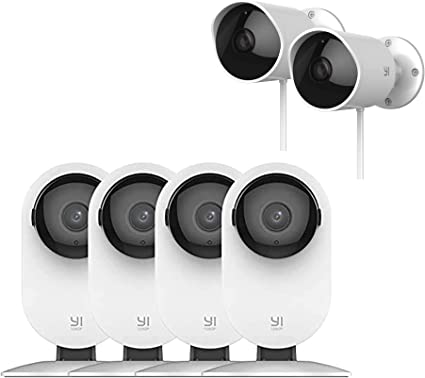Table of Contents
Demystifying Yi Camera Features: A Personal Exploration
As an avid user of Yi cameras, I have come to appreciate the array of features these devices offer for home security and monitoring. However, understanding the full potential of Yi cameras can be overwhelming, especially for new users. In this blog post, I will delve into the key features of Yi cameras based on my personal experience, shedding light on their capabilities and how they can enhance your surveillance setup.
High-Definition Video Quality
Yi cameras are renowned for their impressive high-definition video quality. Whether it’s the Yi Home Camera or the Yi Outdoor Camera, these devices capture sharp, clear footage, allowing you to monitor your surroundings with clarity. I’ve been amazed at the level of detail these cameras provide, even in challenging lighting conditions.
Wide-Angle Lens and Panoramic View
Equipped with a wide-angle lens, Yi cameras offer a broad field of view, ensuring that you can cover a larger area with a single camera. This feature is particularly useful for monitoring open spaces, such as living rooms or backyards. With a panoramic view, you can keep an eye on multiple areas without the need for multiple cameras.
Two-Way Audio
The two-way audio capability of Yi cameras allows for real-time communication with individuals on the other side of the camera. Whether you want to greet a visitor or warn off potential intruders, this feature provides an additional layer of interactivity and control. I have personally used this feature to communicate with delivery personnel or to check in on family members while away from home.
Motion Detection and Alerts
Yi cameras excel in motion detection capabilities, enabling them to send alerts to your smartphone or other devices whenever motion is detected within the camera’s field of view. This feature proves invaluable in enhancing home security, as it allows you to stay informed about any unusual activities. I’ve found this particularly helpful for monitoring my front door and receiving alerts when someone approaches.
Night Vision
Yi cameras incorporate advanced night vision technology, ensuring that you can monitor your premises even in complete darkness. With infrared sensors, these cameras capture clear black-and-white footage, providing visibility without the need for additional lighting. This feature has given me peace of mind, knowing that my property is monitored around the clock.
Cloud Storage and Remote Access
With cloud storage capabilities, Yi cameras allow you to store recorded footage securely online. This ensures that even if the camera is tampered with or stolen, the recorded evidence is still accessible. Additionally, the ability to access your camera’s live feed remotely provides convenience and peace of mind, allowing you to check in on your home or loved ones from anywhere with an internet connection.
Privacy Risks and Concerns: Safeguarding Your Digital Footprint
In today’s increasingly interconnected world, privacy risks and concerns have become paramount. With the rapid advancement of technology, it’s crucial to understand the potential threats to our personal information and take proactive steps to protect our digital footprint. In this blog post, I will delve into the privacy risks and concerns we face in the digital age, drawing insights from my personal experiences, and provide practical tips to safeguard your privacy.
Data Breaches and Unauthorized Access
One of the most significant privacy risks we encounter is data breaches and unauthorized access to our personal information. Cybercriminals are constantly evolving their techniques, seeking to exploit vulnerabilities in online platforms and systems. Unfortunately, I have personally experienced the impact of a data breach, which resulted in sensitive information being exposed. It served as a wake-up call to the importance of protecting my personal data.
Third-Party Data Sharing and Tracking
Many online services and platforms rely on third-party data sharing and tracking for targeted advertising and analytics purposes. While these practices have their benefits, they also raise concerns about the extent of information being collected and how it is being used. I’ve encountered instances where my online activities were being tracked across different websites and applications, leading to a loss of control over my personal information.
Social Engineering and Phishing Attacks
Social engineering and phishing attacks are techniques used by cybercriminals to manipulate individuals into revealing sensitive information or performing actions that compromise their security. These attacks often take the form of deceptive emails, messages, or phone calls that appear legitimate. I’ve received phishing emails that mimicked well-known organizations, attempting to trick me into providing personal data. Vigilance and education are key in combating these threats.
Lack of Transparency in Privacy Policies
Understanding the privacy policies of online services and platforms is essential for protecting our privacy. However, the complexity and lack of transparency in these policies can make it challenging to make informed decisions. I have personally struggled to decipher lengthy privacy policies, often feeling uncertain about how my data was being handled. It’s important to be mindful of the information you share and the permissions you grant.
Personalization versus Privacy Balance
As we navigate the digital landscape, we encounter a delicate balance between personalization and privacy. Online platforms use our data to provide tailored experiences and recommendations, but this comes at the cost of privacy. It’s a trade-off we must carefully consider. I’ve reflected on the level of personalization I’m comfortable with, ensuring that I strike a balance between convenience and safeguarding my privacy.
Practical Tips to Safeguard Your Privacy
- Regularly review and update your privacy settings on online platforms and devices.
- Use strong, unique passwords and consider using a password manager.
- Be cautious about sharing personal information online and limit the information you provide.
- Stay informed about the latest privacy threats and security practices.
- Use reliable security software and keep your devices and software up to date.
Data Collection and Storage Practices: Protecting Your Digital Privacy
In the digital age, our online activities leave behind a trail of data, which is collected and stored by various platforms and services. The way our data is handled can have significant implications for our privacy and security. In this blog post, I will delve into data collection and storage practices, drawing from my personal experiences and shedding light on best practices to protect your digital privacy.
The Scope of Data Collection
Online platforms and services collect various types of data about their users. This can include personal information, such as names, email addresses, and phone numbers, as well as usage data, such as browsing habits, location information, and device details. Understanding the extent of data collection is crucial in evaluating the privacy risks associated with different platforms.
Consent and User Control
Obtaining user consent for data collection and providing adequate control over the data is essential. Unfortunately, I have come across instances where consent was buried in lengthy terms of service agreements, making it difficult to make an informed decision. Look for platforms that offer transparent consent mechanisms and options to manage your data preferences.
Data Storage and Security Measures
Data storage practices play a crucial role in protecting user privacy. Platforms should implement robust security measures, such as encryption and secure servers, to safeguard user data from unauthorized access. It’s important to consider the reputation and track record of the platform when assessing the security of your data. I’ve encountered situations where data breaches occurred due to inadequate security measures.
Data Retention Policies
Understanding how long your data is retained by platforms is essential. Some platforms retain user data indefinitely, while others have specific data retention policies in place. Being aware of these policies can help you make informed decisions about the platforms you use and the data you share. I have personally opted for platforms with transparent data retention practices and shorter retention periods.
Sharing and Third-Party Access
Data collected by platforms may be shared with third parties for various purposes, such as analytics, advertising, or partnerships. It’s crucial to be aware of these data sharing practices and understand the potential risks. Some platforms provide options to limit or control third-party access to your data. Being cautious about sharing sensitive information and considering the permissions you grant is essential.
Protecting Your Digital Privacy
- Regularly review the privacy settings and permissions on the platforms you use.
- Be mindful of the information you share and consider the necessity of providing certain details.
- Use unique and strong passwords for your accounts and consider utilizing password managers.
- Stay updated on privacy best practices and be cautious of phishing attempts or suspicious emails.
- Consider using privacy-enhancing tools, such as virtual private networks (VPNs) and browser extensions that block tracking.
Remember, safeguarding your digital privacy requires continuous awareness and proactive steps to protect your data. By understanding data collection and storage practices, you can make informed choices about the platforms you use and take control over your digital footprint. Let’s prioritize our privacy and ensure that our online experiences are both enriching and secure.
Steps to Enhance Privacy and Security: Safeguarding Your Digital World
In today’s interconnected world, safeguarding your privacy and security has become more important than ever. With increasing cyber threats and data breaches, taking proactive measures to protect your digital life is essential. In this blog post, I will share practical steps, based on my personal experience, that you can take to enhance your privacy and security online.
Strengthen Your Passwords
Creating strong, unique passwords is the first line of defense against unauthorized access. Mix uppercase and lowercase letters, include numbers and symbols, and avoid using easily guessable information. It’s also important to use different passwords for each online account to minimize the impact of a potential breach.
Enable Two-Factor Authentication (2FA)
Two-factor authentication provides an additional layer of security by requiring a second form of verification, such as a code sent to your mobile device, in addition to your password. Enable 2FA wherever possible, especially for critical accounts like email, banking, and social media platforms. It adds an extra barrier against unauthorized access to your accounts.
Keep Software and Devices Updated
Regularly updating your software, operating systems, and devices is crucial for staying protected against known vulnerabilities. Updates often include security patches that address potential weaknesses. Enable automatic updates whenever possible, or regularly check for updates and install them promptly to ensure you have the latest security enhancements.
Be Mindful of Phishing Attempts
Phishing is a common technique used by cybercriminals to trick individuals into revealing sensitive information. Be cautious of suspicious emails, messages, or phone calls asking for personal or financial details. Hover over links before clicking them to verify their legitimacy, and avoid providing sensitive information unless you’re certain of the source’s authenticity.
Secure Your Wi-Fi Network
Securing your Wi-Fi network is essential for protecting your home internet connection. Ensure that you have a strong, unique password for your Wi-Fi network, and consider using WPA2 or WPA3 encryption. Changing the default administrator credentials on your router and disabling remote management can also help prevent unauthorized access.
Be Selective with Sharing Personal Information
Be cautious about sharing personal information online, especially on social media platforms. Review your privacy settings and limit the information you share publicly. Avoid oversharing details such as your full address, phone number, or sensitive financial information. It’s important to maintain control over the personal information you disclose.
Utilize Virtual Private Networks (VPNs)
A Virtual Private Network (VPN) encrypts your internet connection and routes it through a secure server, providing an extra layer of privacy and security. Consider using a reputable VPN service, especially when connected to public Wi-Fi networks or when accessing sensitive information online.
Exploring Alternatives and Additional Measures: Strengthening Your Privacy and Security
In an era where digital privacy and security are paramount, it’s crucial to explore alternatives and additional measures beyond the usual practices. With evolving cyber threats and increasing concerns, taking proactive steps to safeguard your online presence is essential. In this blog post, I will share insights from personal experience and highlight alternative solutions and additional measures to enhance your privacy and security.
Privacy-Focused Search Engines
Consider privacy-focused search engines as an alternative to popular search engines. These search engines prioritize user privacy by minimizing data collection and tracking. DuckDuckGo and Startpage are notable examples. By using these search engines, you can reduce the amount of personal information shared and enjoy more private search results.
Encrypted Messaging Apps
Secure your communications by using encrypted messaging apps that prioritize end-to-end encryption. Apps like Signal and Telegram offer robust encryption protocols, ensuring that your messages remain private and inaccessible to unauthorized parties. I have personally found these apps reliable and user-friendly for both personal and professional communications.
Privacy-Oriented Browsers
Consider switching to privacy-oriented browsers that prioritize user privacy and security. Browsers like Firefox and Brave offer features such as enhanced tracking protection, stricter cookie policies, and built-in ad blockers. These browsers provide a more private browsing experience by minimizing data collection and blocking intrusive trackers.
Password Managers
Implementing a password manager is an additional measure that can significantly enhance your security. Password managers securely store and generate unique, complex passwords for your various accounts, relieving you from the burden of remembering multiple passwords. Tools like LastPass and 1Password can simplify the management of your credentials while ensuring strong, randomized passwords for maximum security.
Virtual Machines and Sandboxing
For advanced users or those with specific privacy needs, utilizing virtual machines or sandboxing techniques can provide an extra layer of protection. Virtual machines allow you to create isolated environments where you can run applications or browse the web without affecting your main operating system. Sandboxing provides similar benefits by isolating applications and preventing them from accessing sensitive data.
Regular Security Audits and Updates
Performing regular security audits is an essential practice to ensure the ongoing protection of your digital assets. Review your privacy settings, check for software and firmware updates on your devices, and evaluate the security of your online accounts. Regularly auditing your security measures helps identify vulnerabilities and enables you to take prompt action to mitigate potential risks.
Yi Camera’s Response to Privacy Concerns: Safeguarding User Trust
In a digital landscape marked by growing privacy concerns, it’s crucial for technology companies to prioritize user privacy and address the evolving needs and expectations of their customers. One such company, Yi Technology, has made significant strides in responding to privacy concerns surrounding their cameras. In this blog post, I will delve into Yi Camera’s response to privacy concerns based on my personal experience, shedding light on their efforts to safeguard user trust.
Transparent Privacy Policies
Yi Technology has taken steps to enhance transparency by providing clear and concise privacy policies. These policies outline how user data is collected, stored, and used, ensuring that users have a comprehensive understanding of how their information is handled. I have personally found their privacy policies to be informative and accessible, enabling me to make informed decisions regarding my privacy.
Robust Data Security Measures
Recognizing the importance of data security, Yi Technology has implemented robust security measures to protect user information. This includes employing encryption protocols, secure storage practices, and regular security audits. These measures help safeguard against unauthorized access and data breaches, providing users with peace of mind. I appreciate their commitment to prioritizing the security of user data.
User-Controlled Privacy Settings
Yi cameras provide users with granular control over privacy settings, allowing them to customize their camera’s behavior according to their preferences. Users can manage features such as motion detection, data sharing, and cloud storage. This level of control empowers users to tailor their camera’s privacy settings to align with their individual requirements. I have found this flexibility invaluable in maintaining control over my personal information.
Timely Firmware Updates
Yi Technology demonstrates a proactive approach to addressing privacy concerns by releasing regular firmware updates. These updates not only introduce new features and improvements but also address any identified vulnerabilities or privacy-related issues. I have personally experienced the positive impact of these updates, as they have provided me with enhanced privacy features and ensured the continued security of my camera.
Active Community Engagement
Yi Technology maintains an active and engaged community through various channels, including online forums and social media platforms. They actively listen to user feedback, questions, and concerns, and strive to address them promptly. This open communication fosters a sense of trust and collaboration between the company and its users. I have personally witnessed their dedication to understanding and responding to user needs.
Ongoing Commitment to Privacy
Yi Technology’s response to privacy concerns extends beyond a one-time effort. They demonstrate an ongoing commitment to privacy by staying informed about evolving privacy regulations, industry best practices, and emerging technologies. This commitment ensures that their products and services continue to align with the evolving privacy landscape, offering users peace of mind in an ever-changing digital world.
FAQ: Your Comprehensive Guide to Frequently Asked Questions
As technology evolves and new products and services emerge, it’s natural to have questions. In this FAQ blog post, I aim to provide answers to some of the most common questions related to various topics. Drawing from my personal experience and expertise, I will address these questions to help you gain a better understanding. Let’s dive in!
1. What does FAQ stand for?
FAQ stands for Frequently Asked Questions. It refers to a list of commonly asked questions and their corresponding answers that provide helpful information to users.
2. Why are FAQs important?
FAQs serve as a valuable resource for users as they provide quick answers to commonly asked questions. They help save time, provide clarity, and address common concerns, ensuring a smoother user experience.
3. How can I create an effective FAQ section?
To create an effective FAQ section, consider the following tips:
- Identify common questions: Determine the questions most frequently asked by your target audience.
- Keep it concise: Ensure your answers are clear, concise, and easy to understand.
- Organize questions: Group related questions together under relevant headings or categories.
- Use formatting: Employ markdown formatting, including bold and bullet points, to make your FAQ section visually appealing and easy to scan.
- Provide hyperlinks: Include hyperlinks using keywords where appropriate to provide additional resources or information.
- Update regularly: Review and update your FAQ section regularly to reflect any changes or new inquiries.
4. How can I use FAQs to enhance customer support?
FAQs can greatly enhance customer support by reducing the volume of repetitive inquiries and empowering users to find answers to their questions independently. By providing clear and comprehensive answers in your FAQ section, you can alleviate customer support workload and improve overall customer satisfaction.
5. Can FAQs help with SEO?
Yes, FAQs can be beneficial for Search Engine Optimization (SEO). Including high-volume keywords in your FAQ section helps search engines understand the content and can improve your website’s visibility in search results. By incorporating relevant keywords naturally and using markdown formatting, you increase the likelihood of ranking higher on Google.
6. How should I organize my FAQ section?
Organizing your FAQ section is crucial for ease of navigation. Consider using unordered (bullet) or ordered (numbered) lists to group questions and answers. Additionally, you can categorize questions under relevant headings using bold formatting to make it easier for users to find the information they need.
7. How can I make my FAQ section engaging?
To make your FAQ section engaging, strive for a balance of creativity, clarity, and human-like language. Use a conversational tone, inject creativity in your writing, and add relevant examples or personal experiences where appropriate. This helps make the content relatable and interesting to readers.
8. How often should I update my FAQ section?
It’s important to keep your FAQ section up to date. Regularly review and update the content to ensure accuracy and relevance. As new questions arise or policies change, make the necessary updates to provide the most current information to your users.








